What we heard — Management plan review, public consultation report, January 2022
Rideau Canal National Historic Site
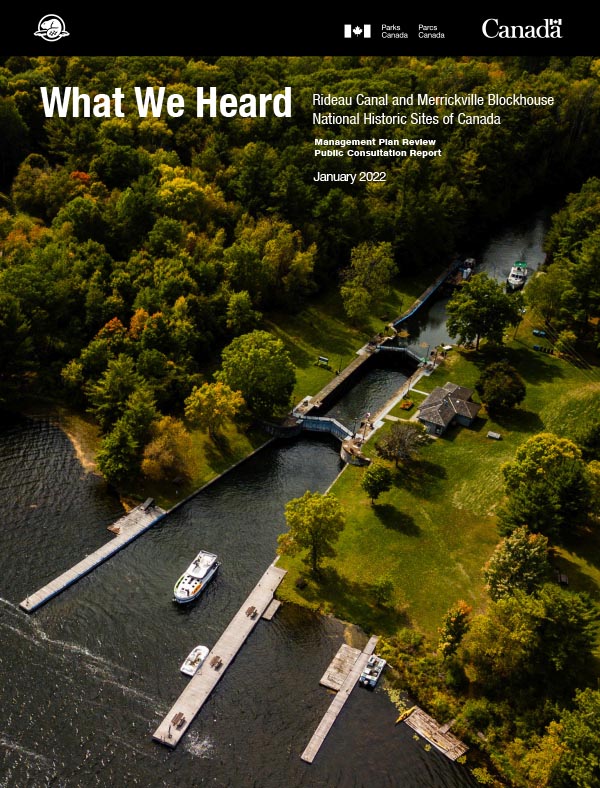
Table of contents
- Introduction and background
- About Parks Canada
- About Rideau Canal and Merrickville Blockhouse National Historic Sites and their management plan
- Engagement and consultation process
- Who we heard from
- What we heard
- Cultural heritage conservation
- Natural environment conservation
- Public and stakeholder engagement and collaboration
- Visitor experience and interpretation
- Regulations, legislation and their enforcement
- Merrickville Blockhouse
- Vision
- Next steps
Title: Rideau Canal and Merrickville Blockhouse — What we heard — Management plan review, public consultation report, January 2022
Organization: Parks Canada Agency
Introduction and background
About Parks Canada
Parks Canada manages Canada’s system of national historic sites, national parks, national marine conservation areas, and Canada’s first national urban park. The mandate of the Parks Canada Agency is:
To protect and present nationally significant examples of Canada’s natural and cultural heritage, and foster public understanding, appreciation and enjoyment in ways that ensure ecological and commemorative integrity of these places for present and future generations.
This mandate includes protecting natural and cultural resources, facilitating inspiring experiences for visitors, and providing public outreach education. Parks Canada plans and manages for the three aspects of its mandate using an integrated approach. Parks Canada’s goal is to make Canada’s places and stories more relevant to Canadians as described in the Agency’s vision statement:
Canada’s treasured natural and historic places will be a living legacy, connecting hearts and minds to a stronger, deeper understanding of the very essence of Canada.
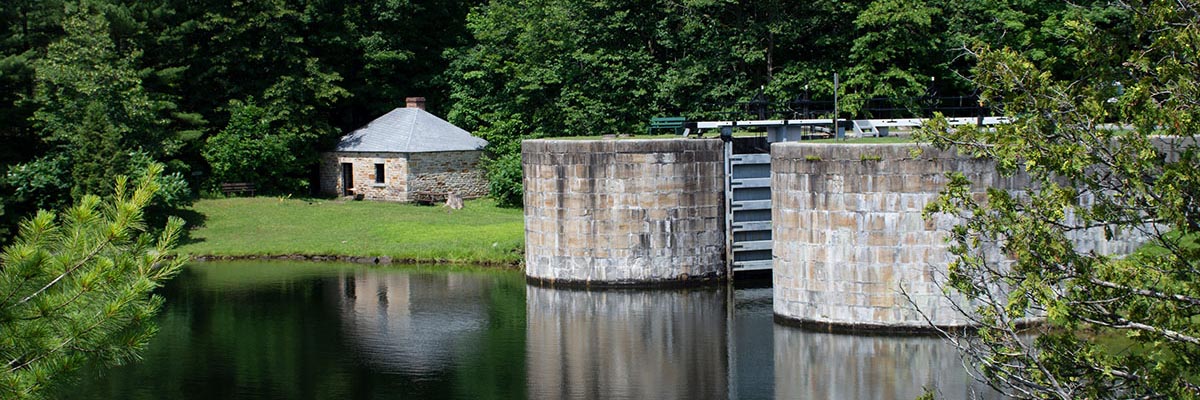
About the Rideau Canal and Merrickville Blockhouse National Historic Sites and their management plan review
The Rideau Canal was conceived in the wake of the War of 1812 to serve as a war-time supply route providing a secure water route for troops and supplies from Montreal to reach the settlements of Upper Canada and the strategic naval dockyard at Kingston. In 1832, the Rideau Canal officially opened with 47 locks, 23 lockstations and supporting dams and bridges, providing through navigation between the Ottawa River and Lake Ontario. First designated a national historic site in 1925, the canal was later inscribed on the UNESCO World Heritage List in 2007. The site is valued for its canal construction and engineering technology, its integrity and authenticity, the contribution and sacrifices of canal construction labourers, its military purpose and its contributions to the social and economic development of Upper Canada.
On the grounds of the Merrickville Lockstation sits the Merrickville Blockhouse. Built in 1832-33, the Blockhouse is the largest and the most impressive of the four blockhouses built along the Rideau Canal and the second largest surviving in Canada. It served a military function only once, in the aftermath of the Upper Canada Rebellions of 1837-1838. In 1939, the blockhouse was designated a national historic site. Since 1966, it has operated as the Blockhouse Museum.
In accordance with the Parks Canada Agency Act and the Canada National Parks Act, a management plan must be developed for the Rideau Canal and Merrickville Blockhouse. The management plan proposes a strategic management approach that aims to integrate the three elements of Parks Canada’s mandate: heritage resource protection, public education and visitor experience. Management plans are developed through consultation with Indigenous people, and through the engagement of partners, stakeholders and the public. The management plan for the Rideau Canal and Merrickville Blockhouse will be submitted for approval by the Minister responsible for Parks Canada, and is intended to serve as the key accountability document to Parliament and to Canadians regarding the management of these sites.
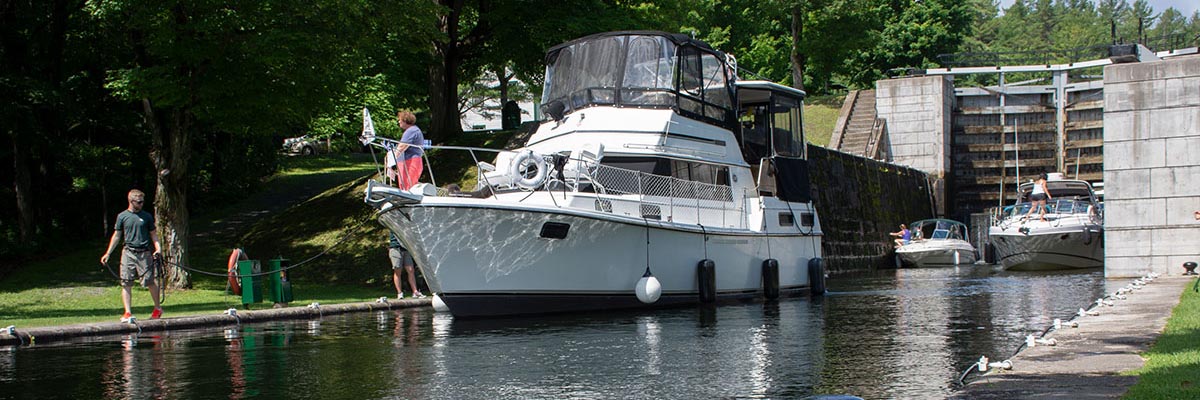
Engagement and consultation proces
Overview of Rideau Canal: The Next Ten Years consultation process
In order to facilitate meaningful opportunities for the public to contribute to the management plan review for the Rideau Canal and Merrickville Blockhouse, a two-phased approach was developed to promote participation from Indigenous peoples, partners, stakeholders and the Canadian public, locally and nationally, using in-person and online approaches to obtain public input.
The phase one engagement activities are briefly summarized in this section, but not discussed in detail in the remainder of the plan.
Phase one engagement activities
Phase one engagement (2016-2019) focused on exploring the opportunities and challenges related to management of the sites, prior to the development of a draft management plan.
Open houses
Supported by a letter to stakeholders and online communications, four open houses were held in June 2016 in the communities of Ottawa, Smiths Falls, Chaffey’s Locks and Kingston to share and discuss the findings of the State of the Site Assessment. This report assessed the condition of indictors for national historic sites pertaining to cultural resources, built assets, visitor experience, external relations and Indigenous relations and highlighted the key issues facing the Rideau Canal. Given the complexity of the site, other indicators reflecting the roles and responsibilities for the Rideau Canal, including species at risk, lock operations, water management, business development and realty and permitting, were also explored.
Stakeholder workshops
Following the 2017 Canadian sesquicentennial celebrations, public engagement activities recommenced in January 2018. Three all-day stakeholder workshops were held on January 18, January 9 and February 2. Over 20 representatives from a wide range of sectors and communities attended, including federal, provincial and municipal government, non-government organizations and not-for profit groups, boating industry, heritage and culture, natural environment and tourism. These interactive workshops provided an overview of the management plan review process, discussed the key issues and opportunities for the site, and brainstormed what the Rideau Canal and Merrickville Blockhouse could be in 10-20 years.
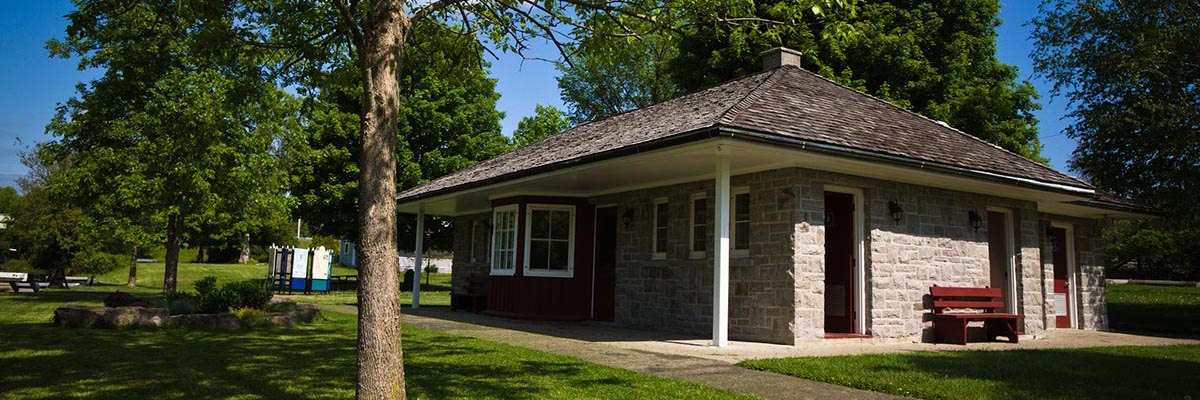
Indigenous consultation
During 2018-2019, Parks Canada engaged with Indigenous peoples to discuss their interests and vision for the Rideau Canal to help inform the draft management plan. Conversations were held with the Algonquins of Ontario, the Mississauga of Alderville and the Mohawk First Nations of Akwesasne and Tyendinaga.
Summary of feedback
Phase one engagement activities identified the importance of conserving the cultural and natural heritage resources and values of the Rideau Canal, including Indigenous knowledge and values, and the role they can serve as a foundation for developing and delivering interpretation, presentation and visitor experiences on the waterway. The feedback reflected the important contributions of the canal in the quality of life and economic sustainability of the region, and the value in working collaboratively with others to conserve, animate and promote the world heritage site.
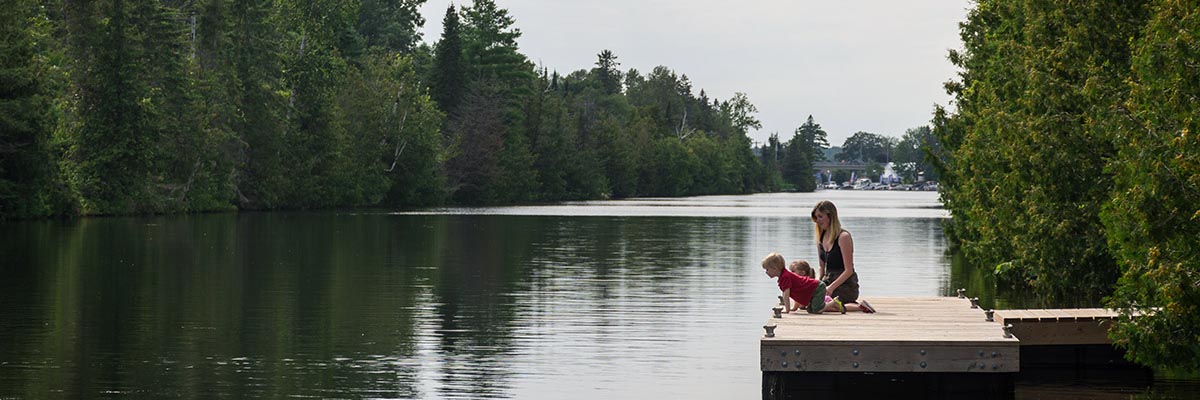
Phase two consultation activities
Due to the COVID-19 pandemic, phase two public and Indigenous consultation on the draft management plan was postponed from 2020 to 2021. To protect the health of all Canadians, a strictly online consultation process was held from January – May 2021.
Virtual stakeholder sessions
Five virtual stakeholder consultation sessions were held with the Friends of the Rideau, the Merrickville and District Historical Society, Rideau Lakes Lake Associations, National Capital Commission, and the mayors of the Village of Merrickville-Wolford, Municipality of North Grenville, Township of Rideau Lakes, Village of Westport and the Township of Leeds and the Thousand Islands. These sessions provided an opportunity to discuss the content of the draft plan, recommendations for inclusion in the final management plan, and opportunities for strengthened communication, cooperation and collaboration between Parks Canada and others.
Virtual public consultation sessions
Four English language and one French language virtual public consultation sessions were held February – March 2021 to elicit feedback on the draft plan. These sessions commenced with a presentation about the management plan review process and a summary of the content of the draft plan. This was followed by an interactive discussion about the importance of the Rideau Canal and Merrickville Blockhouse to individual participants, the content of the draft plan, and opportunities for future engagement.
Direct email and social media awareness
Phase two consultation activities were supported by letters to stakeholders and Indigenous peoples, and communications on social media channels. People were encouraged to provide feedback via email. Fifty (50) individuals and organizations provided written feedback via direct email either through the Rideau Canal common account pc.rideau.pc@canada.ca or directly to staff.
Online consultation
An online engagement platform – www.rideauplan.ca and www.planrideau.ca was developed to facilitate the collection of feedback through a diversity of tools, including surveys, ideas and story-telling, recognizing the varied locations, needs, and preferences of individual participants.
Surveys
Two surveys were available for completion on the website. The Rate Our Plan survey provided registrants an opportunity to evaluate the content of the draft management plan through multiple choice, ranking and open ended questions. A secondary Visitor Survey provided an opportunity to learn more about current visitors to better plan for their future visits.
Ideas
Virtual “Post-it Notes” for participants to add ideas about the Rideau Canal and Merrickville Blockhouse to a collective board, and to build on the ideas of others for the future of the sites.
Stories
This section of the website provided space for participants to share stories about their connection to the Rideau Canal and Merrickville Blockhouse.
Who we heard from
Many very thoughtful and detailed responses were received during the Rideau Canal: The Next Ten Years consultation process. This feedback underscores the strong connection that Canadians, and in particular, Ontarions, feel for the Rideau Canal and Merrickville Blockhouse.
Comments for phase two public consultation were collected from January to May 2021, primarily via the www.rideauplan.ca and www.planrideau.ca websites from January 18, 2021 – May 21, 2021. Canadians also submitted feedback via email and the public and stakeholder consultation sessions.
| Visits to rideauplan.ca / planrideau.ca | 6,100+ |
| Document downloads | 1,433 |
| Engaged participants (registrants who actively contributed) | 359 |
| Rate our Plan survey respondents | 167 (163 EN / 4 FR) |
| Visitor survey respondents | 99 (94 EN / 5 FR) |
| Ideas topic: Great Canadian Outdoor Experiences | 136 indiv. contributors; 860 contributions; 86 “post-it notes” |
| Virtual stakeholder consultation sessions participants | 25 |
| Virtual public consultation sessions participants | 50+ |
| Written submissions | 50 |
| Canada | 98.9% |
| Ontario | 92.9% |
| Quebec | 4.4% |
| Alberta | 0.8% |
| British Columbia | 0.8% |
| USA | 4 respondents |
Approximately 50% of the registrants reported they live along the Rideau Canal and only three (3) participants reported that they have never visited the sites. People of all age groups participated in the survey with 89.1% of registrants over the age of 30.
What we heard
The feedback provided to Parks Canada is organized under seven (7) main headings, reflecting the key themes that arose during the phase two consultation process specific to the Rideau Canal, as well as feedback specific to the Merrickville Blockhouse. Many of these topics are inter-related and could fall under multiple headings. We have, however, reported on each theme under only one topic heading. Comments and feedback received through all sources in the public consultation process were carefully considered, analyzed and summarized, as presented in the topic summaries below.
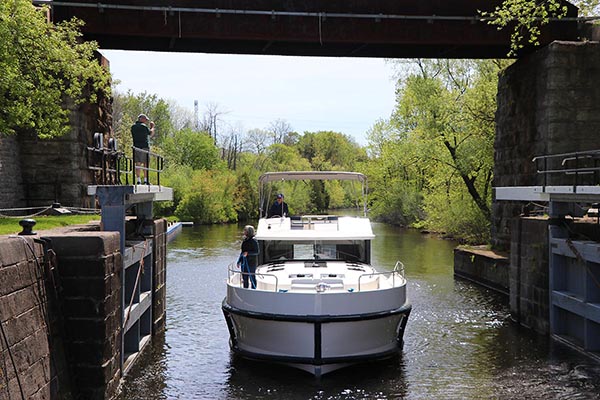
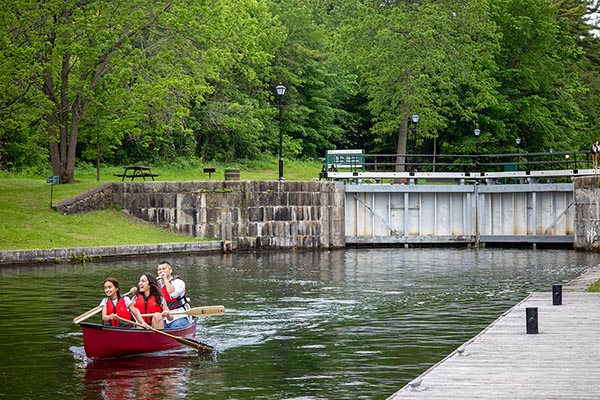
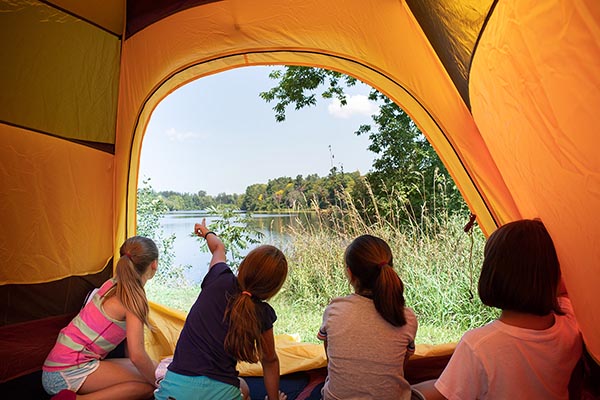
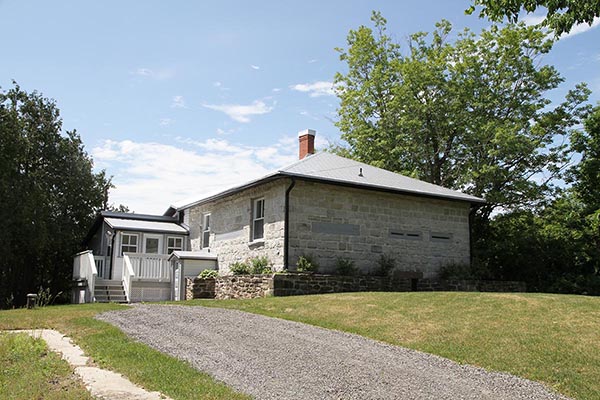
Cultural heritage conservation
A common theme across all consultation media was the desire for greater emphasis within the plan on the conservation of the cultural resources and heritage values of the canal to ensure its commemorative integrity and outstanding universal value.
Whether visitors come for fishing or to have lovely rental boat vacation, [the] foundational aspect of authenticity of the Rideau Canal needs to be protected.
Conservation work and stable funding for maintenance and monitoring to protect cultural resources, including buildings, engineering works and lockstation landscapes, was emphasized as being important aspects to protect the high degree of integrity and authenticity for which the Canal is recognized and beloved. This is supported by a survey question which asked respondents how important they felt the objective was to “protect the Rideau Canal’s engineering marvels, heritage landscapes and natural beauty.” 80% of participants responded that this objective was very important.
It was recommended that more work needs to be undertaken to better understand the cultural landscapes of the lockstations and their heritage values, including values held by Indigenous peoples and local communities, and key viewscapes associated with these landscapes.
It was expressed that a greater understanding and identification of tangible and intangible attributes and values of the canal should then inform other targets and objectives that are proposed in the draft plan, including developing new visitor experiences and offers and developing lockstation master site plans. This should also inform and support ongoing monitoring and maintenance, condition evaluations, and public reporting.
It was felt that there should be a greater emphasis within the plan on the world heritage significance of the waterway and measures to protect the 30m buffer zone and broader landscape setting, including commitments in the plan to continue to advance the work of the Rideau Corridor Landscape Strategy and respond to recommendations from the World Heritage Centre to support management of the site.
Natural heritage conservation
A common theme across all consultation media was the desire for greater emphasis within the plan on the conservation of the natural heritage resources of the canal and its ecosystem. It was felt that this could be achieved through actions by Parks Canada in collaboration with others, including universities, lake associations, municipalities and non-profit organizations, recognizing the multi-jurisdictional nature of the Rideau.
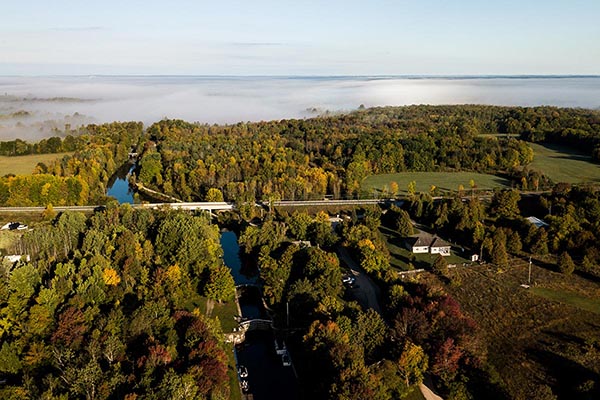
On the Rideau, [a] huge tourism draw is our waters, the recreational side of the canal, general boating, fishing and other on-water activities. The environmental health of our water and integrity of our ecosystems play a huge role in that.
Areas of particular concern where it was felt that Parks Canada should play a stronger role in leading cooperative efforts includes the protection of water quality, species at risk, fish and fish habitat. Degradation of shorelines and the cumulative impacts of development on lands adjacent to the Rideau Canal were also identified as key areas that are having a negative impact on the natural environment of the waterway and should be addressed in this plan by a greater commitment to working with others.
Respondents also communicated concern about the potential impacts of climate change on the waterway and wanted to understand Parks Canada’s approach to assessing and responding to climate change impacts.
Public and stakeholder engagement and collaboration
Regardless of the subject matter, there was shared interest amongst the respondents for a great emphasis within the draft plan to ongoing, regular engagement, collaboration and cooperation with partners, stakeholders, First Nations and the general public.
Particularly because of the challenging environment of the waterway containing multiple jurisdictional authorities, it was felt that Parks Canada, as administrator of the Rideau Canal, should do more to advance cooperation between organizations for more effective and strategic management of the site and its environs. 88% of survey participants agreed that it was important or very important that Parks Canada should “develop and strengthen relationships with strategic partners to better manage the Rideau Canal in a collaborative way.”
While the draft plan speaks to regular meetings with the tourism industry, it was recommended that a similar commitment should be made with respect to authorities that share jurisdiction over the Rideau Canal and to organizations that support the protection of the cultural and natural environment.
Visitor experience and interpretation
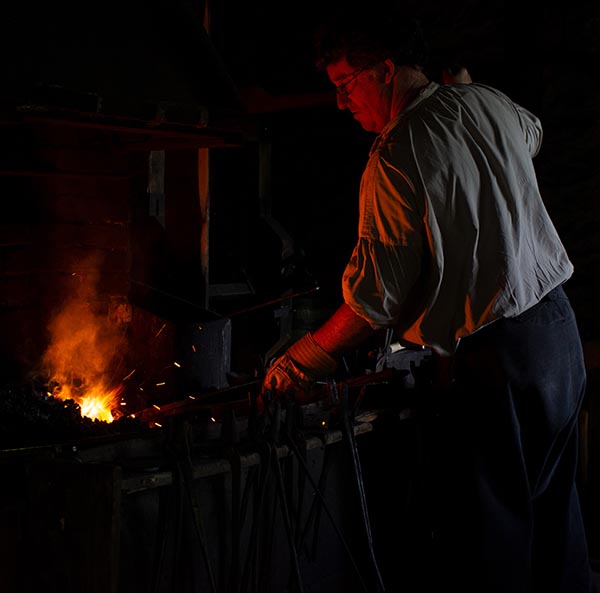
It’s the cultural heritage values of the canal that draw many to the Rideau Canal. They come to see an authentic canal and are looking for a learning experience.
Respondents communicated support for objectives and targets within the plan that allowed for greater opportunities to experience the canal through hiking, paddling, camping and cycling, and a commitment to broadening the traditional motor boating visitor use to include more self-propelled boaters to the waterway. Specifically, 82% of respondents felt that it was important or very important to “diversity visitation through more opportunities for authentic Canadian experiences like paddling, camping, cycling and hiking.”
Some participants expressed concern that the plan placed too much emphasis on attracting new users to the waterway, and did not place sufficient attention to management strategies that support the traditional boating public, including services and facilities such as shore power, docking and operating hours.
Respondents supported the development of a Visitor Experience Strategy but felt it was important to be undertaken in advance of the implementation of new visitor services, amenities and experiences, and should be supported by stakeholder engagement. The Strategy should be based on the authenticity of the site, interpretation and protection of its cultural and natural heritage values.
Respondents felt that the draft plan placed an important emphasis on the visitor experience and tourism potential of the site, but should also contain a commitment to site interpretation, public education and programming that is based on the history, significance and heritage values of the canal, including Indigenous history and values.
Specific to the Ottawa sector of the canal, many respondents expressed interest in greater accessibility across the lock gates for cyclists and other users, better winter maintenance as well as amenities and facilities at lockstations.
The Rideau Canal is recognized as a significant tourism attraction in the region and supported efforts for regular engagement of the tourism industry, local municipalities and businesses to support the tourism potential of the waterway and find collaborative ways to support economic development, marketing and promotions of the site and broader canal corridor.
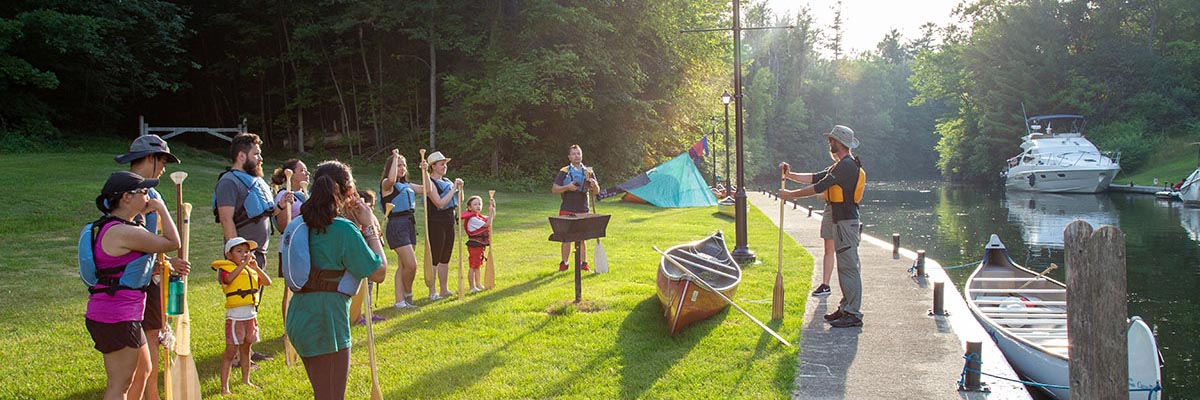
Regulations, legislation, and their enforcement
Many respondents who live in the local area, expressed support for updates to Parks Canada’s 2007 Policies of In-Water and Shorelines Works and Related Activities to help restore, maintain, enhance and protect healthy shorelines along the waterway. However, respondents also felt that it was important that these policies were actively and effectively enforced to ensure compliance.
Many respondents, particularly those who own waterfront property along the canal, expressed concern about the importance of safe use of the canal by all waterway users. In particular, the negative impacts of boat speeds on other users, private property and the environment, especially in narrow sections of the canal, and where there are no-wake zones, were identified as issues that should be addressed in this plan. Conversely, concern was also expressed by other respondents, in reference to the Ottawa sector of the canal, regarding the appropriateness of placing any restrictions at all related to speed or wake on water-based visitors to the site.
People felt more action should be undertaken to enforce the Historic Canals Regulations and to modernize these regulations to support the broad range of functions and usage of the waterway.
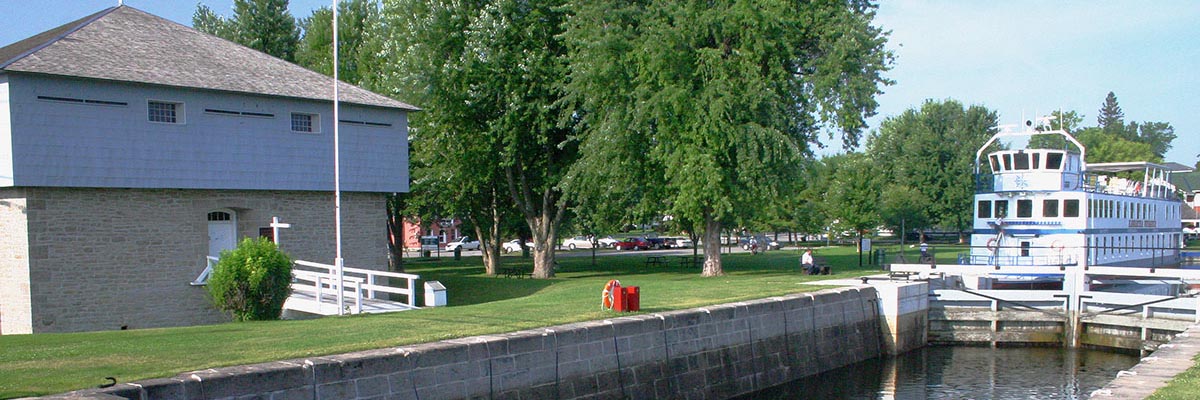
Merrickville Blockhouse
Participants who provided feedback on the management area approach for the Merrickville Blockhouse strongly supported a commitment to strengthening relationships to support the conservation of the building, and site interpretation and programming of the Blockhouse Museum. It was felt that this commitment should begin immediately.
86% of respondents on the survey felt that it was important or very important that the Merrickville Blockhouse remains a celebrated landmark and historical museum within the Village of Merrickville-Wolford.
There was also interest expressed in Merrickville as an appropriate for a master site plan to more effectively and collaboratively support the multiple organizations who operate attractions in the village, including the Merrickville locks, Blockhouse Museum, the Depot, the Industrial Heritage Complex and the Lions Club Campground.
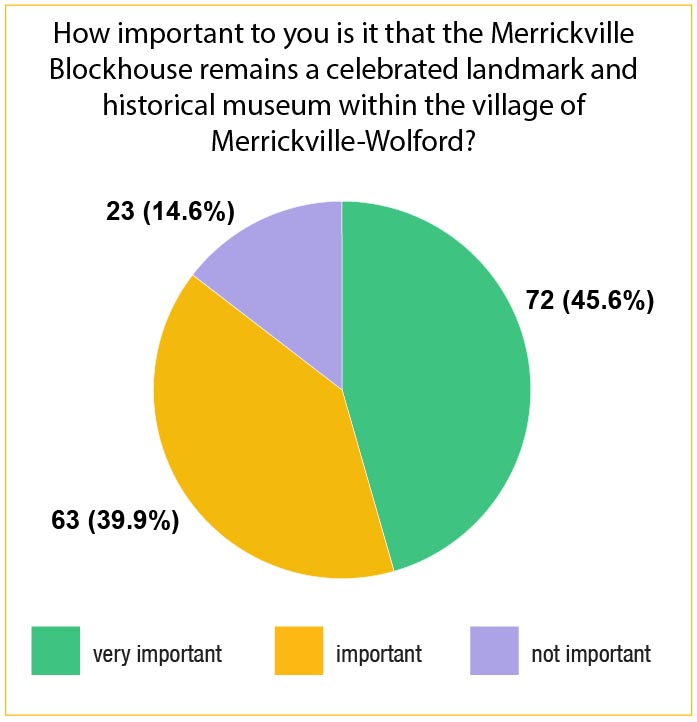
How important to you is it that the Merrickville Blockhouse remains a celebrated landmark and historical museum within the village of Merrickville-Wolford?
| Very important | 45.6% |
| Important | 39.9% |
| Not important | 14.6% |
Figure 1: 86% of respondents on the survey felt that it was important or very important that the Merrickville Blockhouse remains a celebrated landmark and historical museum within the Village of Merrickville-Wolford.
Vision
Respondents’ feedback through open-ended survey questions, written correspondence and consultation sessions highlighted the importance of reflecting the above key themes in the vision for the Rideau Canal and Merrickville Blockhouse. In particular, respondents were interested to see greater acknowledgement of the protection of the cultural and natural heritage resources and values of the waterway, and authentic interpretation and low-impact visitor experiences that support a thriving economic region based on cooperation, collaboration and consultation.
Participants are passionate about the Rideau Canal and this should be reflected through a shared vision for the future of the site.

Next steps
A final question in the online survey asked participants their level of satisfaction with the contents of the draft management plan. 52% of respondents indicated they were satisfied with the plan, while 13% said they were impressed with the draft plan. 35% indicated their dissatisfaction with the contents of the draft plan. However, 80% of respondents reported that they are “very likely’ to participate in further conversations about management planning on the Rideau Canal.
The feedback received during the consultation process is helping to inform revisions to the draft Rideau Canal and Merrickville Blockhouse National Historic Sites of Canada Management Plan.
The perspectives shared during the consultation process will result in meaningful changes to the draft plan in several areas, including cultural resource management, conservation of the natural environment and the approach to undertaking stakeholder and public engagement, cooperation and collaboration.
Once complete, the final plan will be approved by the PCEO of Parks Canada and tabled by the Minister of the Environment and Climate Change in 2022. All participants in the public consultation process will receive direct notification of the public release of the management plan, supported by communications on the public consultation website, the Parks Canada website and via social media channels.
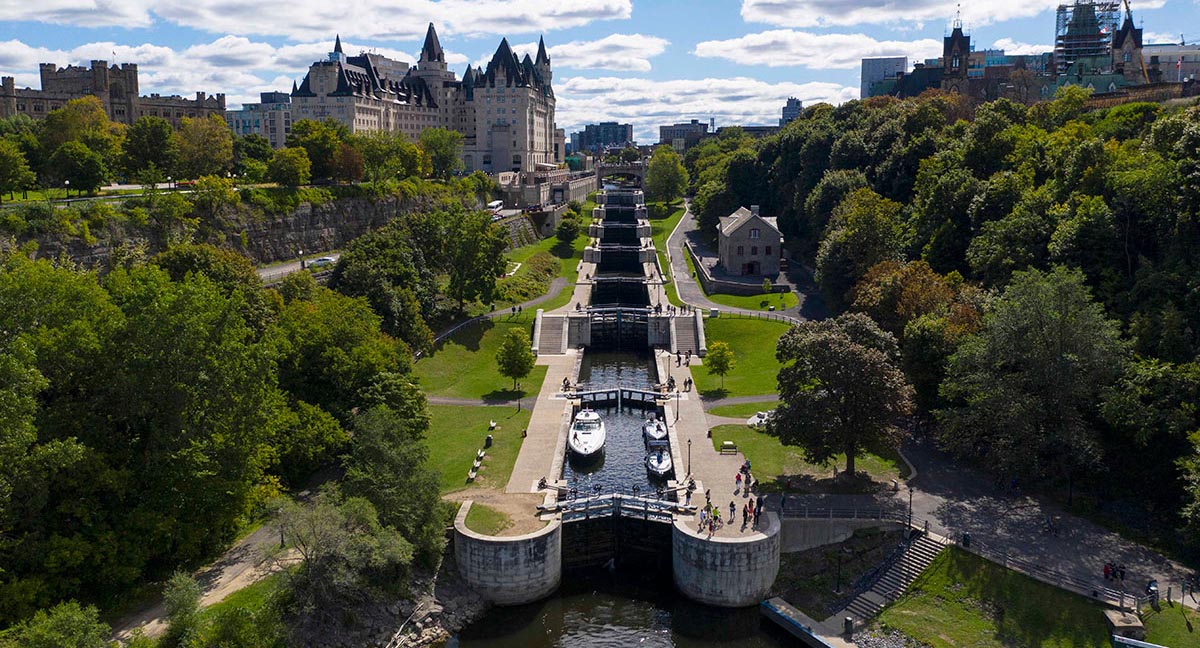
More information
Related links
- Date modified :